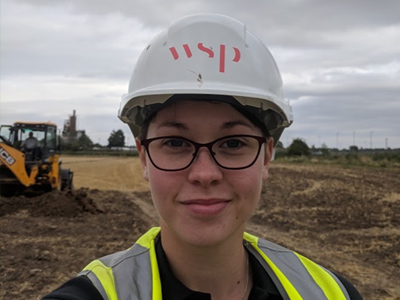
Rae Watney is a Ground Risk Environmental Consultant, working in a technical specialist team in the North of England. She has a Master’s degree in Environmental Geoscience and is a member of the Geological Society.
How would you characterise your current work?
I do fieldwork – investigative studies to assess risks to humans and the environment from soils and contaminated land. I work in the North of England. About half of my time is spent outdoors, around half is office-based.
How do you feel about maths?
For me, it’s very much a means to an end. I use a lot of maths in computer models but that’s using formulae that are based on other people’s work. I very rarely have to figure out any maths myself, as I’m using spreadsheets or models created by others. We do calculate a lot of statistics; for example, to get things through planning or justify levels of risks. Although some people might not count that as maths, I think statistics is maths because it’s a numerical quantification of something – in this case probability.
What is it about your work that is mathematical?
Modelling, statistics, engineering, mechanics, and direct physical measurement or mapping for geotechnical stuff like earth movements. When you build a new development and it has a slope in it, it’s working out whether that slope might fail based on properties of the soil and how you are building it (we do this by working out what level of slope is safe and then multiplying up by 3 or 5 for safety). Our maths has to be reliable, because if we got numbers wrong, the consequences might be severe, up to and including death.
How do you use maths, calculation or numeracy in your work? What tools do you use to help you?
I use statistical spreadsheets the most. I also use ConSim – a particular groundwater modelling programme which works on Monte Carlo simulations. I use models to calculate biological risk. An example might be working out a model for a seven-year-old girl eating soil in a back garden. If she ate a handful every day, how much chemical would have to be in the soil to have a negative effect on her body? We use the seven-year-old girl model a lot; a scientific board by the environment agency deemed it ‘the most sensitive receptor’!

Do you think maths is creative? If so, how?
I certainly think statistics is creative. My definition of statistics is the manipulation of the data set to provide evidence, sometimes regardless of outliers. In my job, dismissing something as an outlier can be ‘a hotspot’ – sometimes we just dig out that one bit of soil and call it an outlier. (Don’t worry, that’s considered acceptable in my field.)
I think maths can be creative – for example, structural engineers use maths very creatively to make building and structures. Creative problem solving is also a part of maths – there are many different solutions to the problem of constructing a building.
Do you use or rely on any maths that you learnt in school?
I use basic quadratic equations, and also the model for groundwater flow within an aquifer is based on Darcy’s Law, which I would use in a spreadsheet or computer programme. We solve equations often as part of our work. I took A Level mathematics and statistics in my first year at university to help with my career development, and I use this level of maths quite a bit, such as integrals.
How would you change the school curriculum, if you had the chance? Why?
I would definitely place more emphasis on critical problem solving, which I would define as using maths to create efficiencies and solve problems. I also think there should be more on how to work out probabilities associated with risk in day-to-day life.
I remember spending a lot of time doing work with circles and I’ve never found a situation, other than lining a cake pan, where I needed it. It’s very interesting, but perhaps more useful things could replace it.
Join the conversation: You can tweet us @CambridgeMaths or comment below.